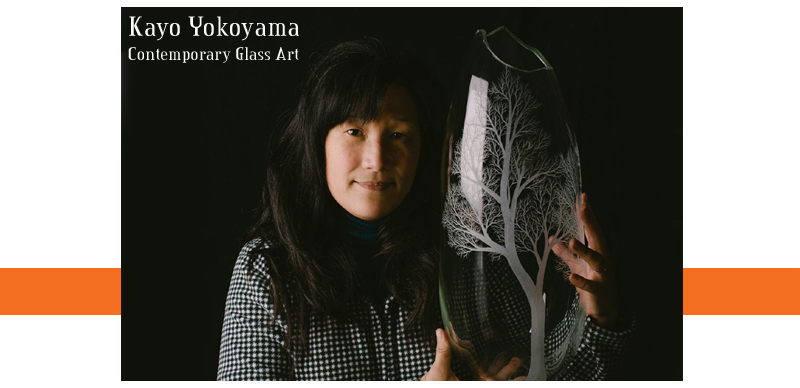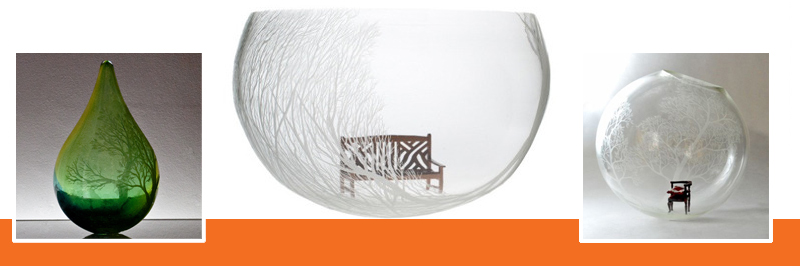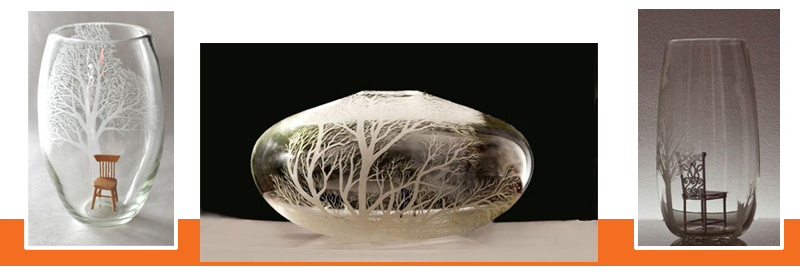In her first solo exhibition at Red Hill Gallery Kayo showcases exquisite pieces of etched glass. This collection, entitled “Homeland”, gives an added dimension to glass art, which is whimsical as well as practical. “Homeland” as the title suggests, is a reflection of the artist’s journey from her Japanese heritage to where she is today. The result is a stunning collection of work, captivating the viewer with its intricate beauty.
 AC: Kayo, how has your Japanese heritage influenced your work?
AC: Kayo, how has your Japanese heritage influenced your work?
KY: The process of creating artworks traces the transformation of my feelings of disengagement with my Japanese background from childhood to adulthood. I did not consider Japan as my homeland for many years due to my desire for idealised aspects of Western culture. I gather my thoughts on being born Japanese and conclude that Japan, and being Japanese, is fundamental to my being and my soul. Through this reflection I reconnect with my homeland.
AC: “Homeland” is a reflection of the journey from your childhood in Japan to your life in Australia, what have been some milestones or obstacles along this journey?
KY: I experienced as a child; allowing my dream for an alternate identity to be created. Ironically motifs of my childhood which hold emotional attachments bring me back to myself by allowing me to see the hollowness of the symbolism that had been my desired identity
AC: You often talk about identity, what does identity mean to you?
KY: How my identity is formed, how it mediates and how it relates to belonging – or not belonging – is the subject of my artworks. Is identity about similarity and difference and the relational position I take at any one time, or is it something that is inherent in me? Do I take it with me wherever I go and whoever I compare myself to? The word ‘identity’ is generally used when talking about the relationship of the individual to society. Erik Erikson (1902-1994) noted in 1950 ‘we begin to conceptualise matters of identity at the very time in history when they become a problem.’ Searching for identity became a survival mechanism in mass society. Identity is what I am and who I am and where I belong.
AC: What do you like about working in the medium of glass?
KY: Clarity and hardness of the medium.
AC: Tell us about the process of creating glass art, what are some of the things you need to take into consideration when designing a new piece?
KY: I always aim to lure audiences to touch my artwork. When it happens, I have successfully created a connection between myself and audiences, artwork conveys my feelings.
AC: You liken the experience of engraving your work to zen meditation, can you elaborate more on this?
KY: Having come to conclusions about my dual identity, Buddhist Zen Master Dogen’s philosophy concerning self-awareness and enlightenment. Zen Master Dogen’s theories are the foundation of my explanation of my own theories of ‘self’ represented through the symbolism of chairs and trees as motif in my own artwork. His theory supports the discovery of the ‘self’ through meditation and mindfulness and encapsulates an emphasis on providing greater understanding of self. There are two layers to this in my art practice: when I engrave, it is a meditative process that directs my consciousness outside myself while the images themselves, empty chairs set among trees, invite the viewer into private contemplation by evoking the memory of sitting in a park or garden surrounded by nature.

AC: What is your favourite thing about Australia?
KY: Landscapes
AC: What inspired you to engrave the trees in this series?
KY: My artworks are about enlightening myself about the world in which we belong. When I first arrived in Australia, I was astonished by the size of the land. The land allows trees to grow huge yet they do not cover the land completely. The landscape and trees are a motif for my transition to my new homeland. They represent a combination of continuation and change. In Australia, I live among trees: trees are an essential factor for me to feel connected and at home. This experience reminds me of a childhood memory of being among trees, with dappled lights shining between the leaves and branches creating new patterns on the ground. This in turn, takes me back to my pattern drawing on the wall of buildings near my childhood home. The presence of a chair in my work is a reference to my adoption of the West and the contradictions inherent in this immigration. It indicates both a presence and an absence. Presence is evoked, in that a chair suggests a sitter: despite being empty it is waiting to be occupied. The chair also suggests contemplation and rest. Equally, the empty chair signifies absence. An empty chair is an invitation to the viewer that there is a place for them in the work.
AC: Who are your 3 favourite artists?
KY: Yayoi Kusama , Brook Andrew, Ah Xian
AC: Tell us something about yourself that we don’t already know?
KY: Mummmm, no secret here!
AC: What is the view from your window?
KY: Beautiful big gum trees.
AC: What music do you listen to?
KY: RR, love Karaoke!
AC: Tell us your favourite place in Australia.
KY: Blue Mountains
AC: How do you spend your time when you are not working on your art?
KY: Sitting on the couch with my dog and thinking about next project.
AC: Describe your art in three words.
KY: Delightful, enlightenment and clean
Kayo studied at Sydney College of the Arts and received a full scholarship to attend Penland School of Crafts.



